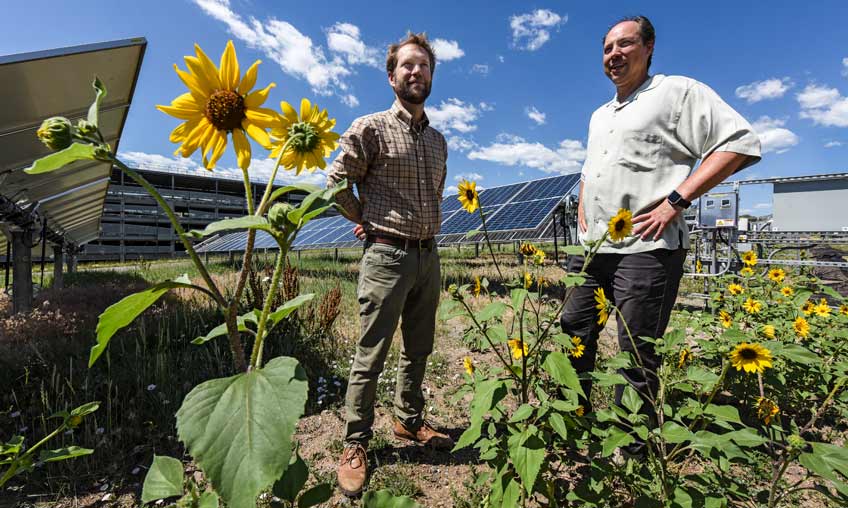Researchers Propose Techno-Ecological Synergy for Solar-Sustainability Win-Win

Have you ever looked at solar panels on a rooftop? Have you ever wondered about the panels’ usefulness to that structure beyond their ability to capture energy from the sun, such as how their shadows can help lower the building’s cooling costs in the summer?
In their newly published article for the journal Nature Sustainability, “Techno-ecological synergies of solar energy produce beneficial outcomes that mitigate global environmental change,” NREL researchers Jordan Macknick and Garvin Heath, and their co-authors, propose a techno-ecological synergy (TES) framework to help capture such win-win outcomes in solar energy.
The researchers describe examples of 16 solar energy TESs and 20 potential TES outcomes, as well as provide a set of metrics and means of assessment to measure TES flows. They argue that the employment of such synergies described by the conceptual model and framework offer a promising path forward toward incorporating solar energy TES into industry and society.
While solar generation helps to significantly reduce emissions in the energy sector, ground-mounted solar arrays can still lead to environmental degradation. Solar-driven land-use change can harm biodiversity and can damage water, air, and soil quality as well.
When developed with TES, however, the study finds that solar projects can mitigate, or even avoid, such environmental degradation. It identifies examples of solar energy TES outcomes, demonstrating that solar energy TES is achievable across a variety of environments—land, food, water, and built-up systems—and is capable of producing beneficial technological and ecological outcomes.
Land Use at its Full Potential
Optimizing land resources by installing solar energy infrastructure on degraded lands or co-locating solar with other renewable energy infrastructure can maximize energy production while sparing scarce land resources. For example, researchers found that Superfund sites in the United States could be used for solar energy production, which could generate more than 1.6 million GWh of potential solar energy per year.
Co-location with agriculture is another means of producing mutually beneficially solar energy generation outcomes. Agrovoltaic systems, co-locating food or energy crop production and solar energy generation, can ensure land is used to its full potential. For example, shade-loving crops can thrive in the shadows of the solar panels, reducing evaporation and improving water usage.
Rangevoltaic systems, or solar energy generation within livestock grazing areas or intensive animal-solar systems, such as dairy farms, is another example of a TES. The shade provided by the solar panels can reduce livestock heat stress and improve milk yields and quality.
In regions where land has more valuable uses than electricity generation, floatovoltaics, photovoltaic (PV) models attached to pontoons that float on water, can be an appealing option. Floatovoltaics can reduce water evaporation, reduce algae growth, and can be integrated over hydroelectric reservoirs. The 1-megawatt canal solar power project in Gujarat, India, for example, prevents the evaporation of 34 million gallons of water per year.
Solar energy production within the built environment—developed places where humans live and work—requires no additional land for energy generation. For example, due to its roof-shading effects, the use of solar PV panels on rooftops in Paris resulted in a 12% decrease in the energy demand for air conditioning during the summer months.
This study demonstrates a promising future for low-impact solar development. As Macknick explained, "solar projects, when done using the principles of techno-ecological synergies, have the potential to improve air, water, and soil resources in addition to producing clean energy." By optimizing land resources through agrovoltaics, rangevoltaics, or floatovoltaics—or installing solar on degraded lands or within the built environment—it indicates that solar energy generation need not compete with environmental sustainability.
Last Updated May 28, 2025
